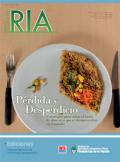View Item
- xmlui.general.dspace_homeCentros Regionales y EEAsCentro Regional La Pampa - San LuisEEA AnguilArtículos científicosxmlui.ArtifactBrowser.ItemViewer.trail
- DSpace Home
- Centros Regionales y EEAs
- Centro Regional La Pampa - San Luis
- EEA Anguil
- Artículos científicos
- View Item
Estiación de la Huella de Carbono del proceso de panificación en la cadena agroindustrial del trigo
Abstract
Las cadenas alimentarias son responsables, en todo el mundo, de una gran parte de las emisiones totales de gases de efecto invernadero. La Huella de Carbono (HC) representa un indicador que pretende cuantificar la cantidad total de emisiones de gases de efecto invernadero -expresada en equivalentes de dióxido de carbono- causadas directa o indirectamente por una actividad o las acumuladas durante la vida o etapas de un producto. El objetivo del presente
[ver mas...]
Las cadenas alimentarias son responsables, en todo el mundo, de una gran parte de las emisiones totales de gases de efecto invernadero. La Huella de Carbono (HC) representa un indicador que pretende cuantificar la cantidad total de emisiones de gases de efecto invernadero -expresada en equivalentes de dióxido de carbono- causadas directa o indirectamente por una actividad o las acumuladas durante la vida o etapas de un producto. El objetivo del presente trabajo fue estimar la HC del proceso de panificación incluyendo las etapas de producción primaria, molienda, panificación, consumo y los transportes del trigo y de la harina y, además, comparar la HC del pan producido en Argentina con respecto al producido en Brasil y China, en función de las matrices energéticas de cada país. Para el cálculo de la HC, se relacionó el consumo energético promedio por unidad funcional de cada etapa, con su factor de emisión unitario de gases de efecto invernadero, expresado en Kg eq-CO2. El valor de la HC de 1 Kg de pan, varió entre 0.502 y 1.323 Kg eq-CO2. Las etapas de mayor
contribución fueron consumo, panificación y producción primaria. Teniendo en cuenta, las matrices de generación eléctrica de Argentina, Brasil y China, se observó que la HC del pan producido en Argentina, fue mayor en 0.42 Kg eq-CO2 Kg de pan-1 con respecto al pan producido en Brasil, pero menor en 0.62 Kg eq-CO2 Kg de pan-1 al producido en China. Lo anterior, determina que uno de los principales responsables del tamaño de la HC de los productos es la matriz energética de cada país. Conociendo el valor de la HC del pan de trigo, el consumidor puede decidir qué producto comprar y cómo consumirlo, y los actores involucrados en la cadena de panificación, pueden optimizar el proceso productivo.
[Cerrar]
Food chains are responsible, in the world, of a large part of the total emissions of greenhouse gases. The carbon footprint (CF) represents an indicator that attempts to quantify the total amount of greenhouse gas
emissions - expressed in carbon dioxide equivalent - caused directly or indirectly, by an activity or the accumulated during life or stages of a product. The objective of the present work was to estimate the CF of the baking process, including
[ver mas...]
Food chains are responsible, in the world, of a large part of the total emissions of greenhouse gases. The carbon footprint (CF) represents an indicator that attempts to quantify the total amount of greenhouse gas
emissions - expressed in carbon dioxide equivalent - caused directly or indirectly, by an activity or the accumulated during life or stages of a product. The objective of the present work was to estimate the CF of the baking process, including the stages of primary production, milling, baking, consumption and the corresponding transport of wheat and flour and in addition, compare the CF of the bread produced in Argentina with respect to that produced in Brazil and China, according to the energy matrices of each country. For the calculation of the CF, related the average energy consumption per functional unit of each stage, with their mission factor unit of greenhouse gases, expressed in Kg eq-CO2. The value of CF of 1 kg of bread, it has varied between 0.502 and 1.323 Kg eq-CO2. The more advanced stages of contribution were consumption, baking and primary production. Taking into account, the matrices of power generation from Argentina, Brazil and China, it was observed that the CF of the bread produced in Argentina, was higher at 0.42 Kg eq-CO2
Kg of bread-1 with respect to the bread produced in Brazil, but lower in 0.62 Kg eq-CO2 Kg of bread-1 that produced in China. The foregoing, determines that one of the main responsible of the size of the CF of the products, it is the energy matrix of each country. Knowing the value of the CF of the wheat bread, the consumer can decide which product buy and how consuming it and the actors involved in the bakery chain, optimize the productive process.
[Cerrar]

Author
Sirotiuk, Patricia Valeria;
Viglizzo, Ernesto Francisco;
Fuente
RIA, 39 (3) : 281-289
Date
2013-12
Editorial
Gerencia de Comunicación e Imagen Institucional, DNA SICC, INTA
ISSN
1669-2314
Formato
pdf
Tipo de documento
article
Palabras Claves
Derechos de acceso
Abierto
 Excepto donde se diga explicitamente, este item se publica bajo la siguiente descripción: Creative Commons Attribution-NonCommercial-ShareAlike 2.5 Unported (CC BY-NC-SA 2.5)
Excepto donde se diga explicitamente, este item se publica bajo la siguiente descripción: Creative Commons Attribution-NonCommercial-ShareAlike 2.5 Unported (CC BY-NC-SA 2.5)


